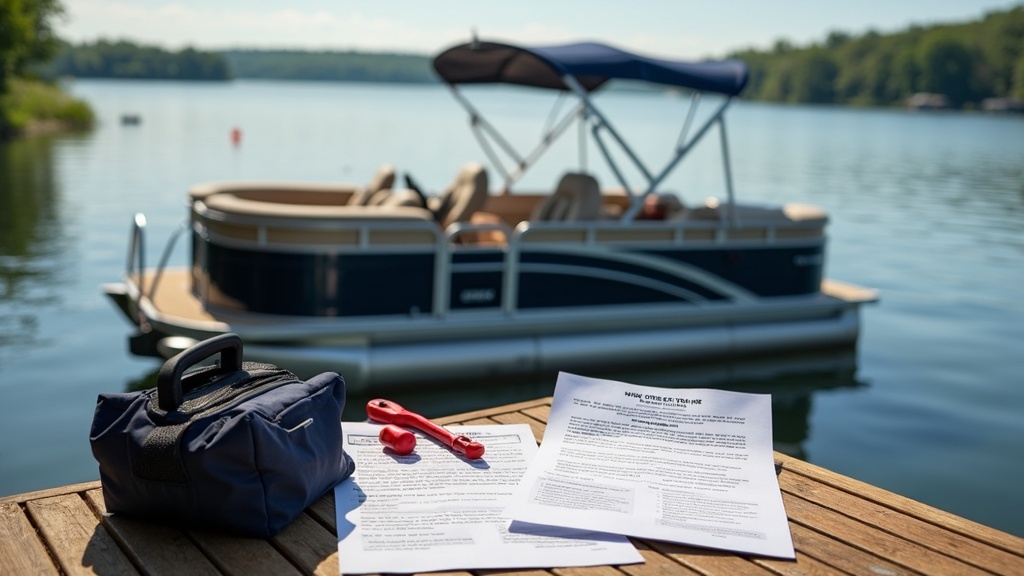Pontoon boats are known for their comfort, versatility, and good times out on the water.
When you’re picking out a new pontoon, the topic of warranties and guarantees is bound to come up. Trying to figure out what these warranties cover and how good the guarantees are can feel like sorting through a mountain of paperwork.
I’ve been through this process myself, and getting a handle on the details helped me feel far more confident in my choice.

What Are Pontoon Boat Warranties and Guarantees?
When you buy a pontoon boat, the manufacturer or dealer usually offers warranties and some form of guarantee. These protect you from certain unexpected problems after your purchase. Think of it as a promise that your new ride won’t fall apart on day one. If it does, the company will step in to help fix it.
Warranties are written agreements that lay out what repairs and services the company will handle (often at no extra cost) during a set period. A guarantee is typically a more general statement of confidence in their product, like a satisfaction or money-back promise. The details really matter because they determine just how much backup you have if issues show up down the road.
Why Pontoon Boat Warranties Matter
Pontoons aren’t exactly cheap. Repairs for boats can get costly, especially with specialized materials or custom features. Warranties become a kind of safety net, covering big-ticket fixes on the structure, engine, or accessories. Having a reliable warranty helped me relax—not just at the time of purchase, but over several summers of use. It’s one of those things you hope to never need, but when you do, you’re glad it’s in place.
Warranties also matter when it’s time to sell or trade in your boat. Boats with transferable warranties can be more attractive to buyers and might even help your resale value hold steady. Solid guarantees show that the manufacturer stands behind their boats. That’s something I always appreciate when comparing brands. Some buyers make warranty coverage one of their top priorities when shopping for used boats, and it can set your listing apart from others.
The Main Types of Pontoon Boat Warranties
Boat warranties aren’t all the same. Here’s a quick rundown of what you’ll usually see offered with pontoon boats:
- Structural/Lifetime Warranty: Covers the main frame, deck, and pontoons (logs). Some brands advertise these as “lifetime,” but always check what exactly is included.
- Limited Warranty: This is more specific and usually covers parts like furniture, electronics, and the boat’s exterior. There’s usually a set timeframe for each component.
- Engine Manufacturer’s Warranty: Often handled separately from the boat manufacturer, this covers the outboard motor or engine. The documentation typically comes directly from the engine company, and the coverage length can differ from the rest of the boat.
- Pro Rated Warranty: After a certain number of years, you might only get partial coverage. For example, in years 6-10, you pay a portion of the repair costs, while in the first few years, most repairs are fully covered.
- Transferable Warranty: Lets you pass warranty benefits to a new owner if you sell the boat within the warranty period. This feature can make a boat more appealing on the resale market and boost buyer confidence.
Carefully reading the fine print on each of these types makes a real difference-you’ll know what’s protected and where you might need to budget for repairs later. Some warranties sound great at first but leave out important items, so double-check the actual coverage lists.
Understanding Warranty Terms and Conditions

Pontoon boat warranties usually spell out what’s covered, for how long, and under what circumstances. These are some key details I watch for when reviewing warranty paperwork:
- Coverage Start Date: Usually starts when you take delivery, but check if it starts on the purchase date or launch date. Sometimes boats sit in storage before being delivered, and it’s good to know when your protection begins. Don’t overlook these dates—they can vary based on the dealer or manufacturer.
- Exclusions: Normal wear and tear, misuse, or improper maintenance often aren’t covered. Any sign of neglect might void the warranty. Flood damage, collision, or damage from improper storage can also lead to denied claims, so consider where and how you’ll store your boat and read the exclusions list carefully.
- Maintenance Requirements: Keeping up with routine maintenance isn’t just good for the boat—it’s often a warranty requirement. I always keep a log and hold onto receipts just in case. Proper documentation can be the difference between an approved or denied claim. Try to take photos after each major service for a digital record.
- Registration: Some warranties require you to register shortly after purchase. Missing this step could leave you out of luck down the line. I set reminders on my phone for deadline dates just to be safe!
Some companies require repairs at an authorized service center. Others are more flexible, letting you use a trusted local mechanic as long as they’re certified. If you live far from a dealership, this can really matter. You wouldn’t want to haul your pontoon hundreds of miles for each fix. Checking the service locations ahead of time may save you hassles in the future.
How to Compare Pontoon Boat Warranties
Narrowing down your options is a whole lot easier if you compare warranties side by side. Here are a few practical steps I follow:
- Read the Entire Policy: Salespeople sometimes highlight the best sounding parts, but reading the whole document myself helped me spot limits and exclusions that otherwise might catch me off guard down the road.
- Check Length and Coverage: Some offer three to five years, others promise “lifetime” coverage on the structure. See if those claims cover just the hull or all structural elements, like brackets, supports, or rails. The details are important to catch in print.
- Find Out About Transferability: Ask if the warranty can be handed over to a new owner. If you plan to upgrade in a few years, this could add value. Transferable warranties can require you or the new owner to fill in special forms within a time window, so be sure to ask how it all works.
- Ask About the Claims Process: Does the company have a good record of honoring claims? I found online reviews and forums pretty handy for real stories from other owners. Dig into customer service reputation for an idea of how smoothly claims go in practice.
Comparing warranties is a bit like checking insurance policies. They may seem similar at first, but small details can make a big difference in your protection. Try to list out important differences in a spreadsheet to help the decision.
Common Mistakes When Evaluating Warranties
While researching boat warranties, I came across several pitfalls that can cause headaches later. Here are a few to watch out for:
- Assuming All Parts Are Covered: Upholstery, electronics, and accessories might have shorter warranty periods or not be included at all. Ask specific questions about these areas to avoid surprise expenses.
- Not Counting Exclusions: Saltwater usage, commercial applications, or custom modifications often void warranties. Even using your pontoon as a rental can be enough to lose protection.
- Ignoring Registration Deadlines: If you need to register your warranty within a set time, don’t put it off or you could lose coverage. Some companies only give you thirty days to activate certain benefits.
- Skipping Routine Maintenance: Not following the manufacturer’s service schedule can lead to rejected claims. Even simple things like skipping oil changes or winterization might put your warranty at risk.
One friend of mine skipped logging oil changes and ended up paying out-of-pocket for an engine problem that would have been covered. Keeping records is a good habit that really pays off. In addition to keeping receipts, try making a digital folder with scanned paperwork for easy access if a problem arises and you need to submit documentation quickly.
Advanced Tips for Protecting Your Pontoon Investment
Getting the most out of your warranty and keeping your pontoon in top shape takes a bit of extra work, but it’s worth it:
- Store and Cover Your Boat: Keeping your pontoon out of harsh weather when not in use helps avoid damage that warranties might not cover. Invest in a well-fitting cover that protects against sun, water, and debris. Indoor or covered storage goes a long way to keeping your boat looking sharp and protected.
- Inspect Regularly: Regular walkthroughs can catch small issues before they grow. I look for loose hardware, fading upholstery, or leaks after heavy rains. Catching mold, mildew, or corrosion in early stages gives you a shot at easier (and sometimes covered) repairs.
- Follow Service Intervals: Stick to the maintenance schedule in the owner’s manual. Keeping up here helps strengthen warranty claims if needed. Some dealers offer packaged service plans that coordinate with warranty requirements—worth asking about if you want reminders or bundled costs.
- Stay Organized: Keep your warranty paperwork, service records, and all communications. This makes things smoother if you ever need to file a claim. Using a dedicated folder or binder can ensure you don’t misplace a vital receipt or email.

Staying on top of care and documentation is super important for protecting your warranty rights down the line. The more organized you are, the smoother things go if a problem does arise. Some savvy boaters even create a checklist for seasonal maintenance and warranty check-ins, which brings peace of mind when the boating season gets busier.
Example Warranty Coverage Scenarios
To bring it out of the fine print and into the real world, here’s how different warranty coverage might play out:
- Structural Problem: A weld seam on a pontoon log starts leaking during year three. With a good lifetime structural warranty, I’ve seen this repaired with no charge except for transportation to an authorized shop. Sometimes, if you’re near an authorized repair technician, this can happen quickly and without any surprise costs. It really pays to check if a mobile repair option is available as well.
- Upholstery Rip: If the furniture warranty is two years, but a seam pops at two and a half years, you might be looking at paying for the repair out of pocket. Occasionally, if you are close to your dealer and have a good relationship, they may offer a discounted fix, but don’t expect this as a given.
- Motor Issue: Outboard engines sometimes have their own separate coverage, often from a different company. I always verify who handles engine repairs to avoid confusion in a pinch. Even if your boat and motor are the same age, the warranty windows for each can be completely different, so keep both sets of paperwork and numbers handy.
Understanding how these scenarios work out can help you track down the best protection and avoid headaches. Each case shows why it pays to be proactive with maintenance and paperwork-little steps add up to big savings down the road.
Frequently Asked Questions
These are some of the questions I hear most often when folks are shopping for pontoons and sorting through warranty information:
Question: Can I upgrade my pontoon and still keep the warranty?
Answer: Most warranties don’t cover after market modifications. Adding things like towers or extra electronics might void part of your coverage, so double-check your terms before making upgrades. If you’re considering a big change, ask your dealer or manufacturer how it might affect coverage and be sure to get the response in writing, if possible.
Question: What if I need a repair far from my original dealer?
Answer: Many warranties let you use authorized shops nationwide, but check first. Some require repairs at the selling dealer, especially for warranty claims. If you travel or keep your pontoon at a seasonal home, it’s worth researching the location of authorized repair shops before a problem comes up.
Question: Is a longer warranty always better?
Answer: Length is good, but what the warranty actually covers is more important. A short but all in one warranty can be more helpful than a long, limited one. Also, some manufacturers offer customer service hotlines during the warranty period, which can be an extra help if you run into odd or technical issues along the way.
Pontoon Warranty Wrap-Up: Protecting Your Investment
Looking at pontoon boat warranties isn’t the most exciting part of buying a boat. Still, putting in a little effort really pays off. Understanding the details saves stress and money later. I always recommend careful reading, asking lots of questions, and staying organized with your paperwork. That way, you can focus less on repairs and more on cruising, relaxing, and making memories out on the water. The comfort and peace of mind from a solid warranty are worth the extra homework when it comes time to choose your next pontoon.
**Here’s a little transparency: Our website contains affiliate links. This means if you click and make a purchase, we may receive a small commission. Don’t worry, there’s no extra cost to you. It’s a simple way you can support our mission to bring you quality pontoon boating content.
